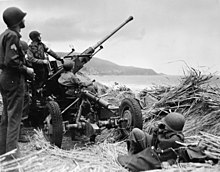
Anti-aircraft warfare
Measures to combat enemy aerial forces / From Wikipedia, the free encyclopedia
Dear Wikiwand AI, let's keep it short by simply answering these key questions:
Can you list the top facts and stats about Anti-aircraft warfare?
Summarize this article for a 10 years old
Anti-aircraft warfare, counter-air, anti-air, AA guns, layered air defence or air defence forces is the battlespace response to aerial warfare, defined by NATO as "all measures designed to nullify or reduce the effectiveness of hostile air action".[1] It includes surface based, subsurface (submarine launched), and air-based weapon systems, associated sensor systems, command and control arrangements, and passive measures (e.g. barrage balloons). It may be used to protect naval, ground, and air forces in any location. However, for most countries, the main effort has tended to be homeland defence. NATO refers to airborne air defence as counter-air and naval air defence as anti-aircraft warfare. Missile defence is an extension of air defence, as are initiatives to adapt air defence to the task of intercepting any projectile in flight.

| Part of a series on |
| War |
|---|
|
In some countries, such as Britain and Germany during the Second World War, the Soviet Union, and modern NATO and the United States, ground-based air defence and air defence aircraft have been under integrated command and control. However, while overall air defence may be for homeland defence (including military facilities), forces in the field, wherever they are, provide their own defences against air threats.
Until the 1950s, guns firing ballistic munitions ranging from 7.62 mm (.30 in) to 152.4 mm (6 in) were the standard weapons; guided missiles then became dominant, except at the very shortest ranges (as with close-in weapon systems, which typically use rotary autocannons or, in very modern systems, surface-to-air adaptations of short-range air-to-air missiles, often combined in one system with rotary cannons).